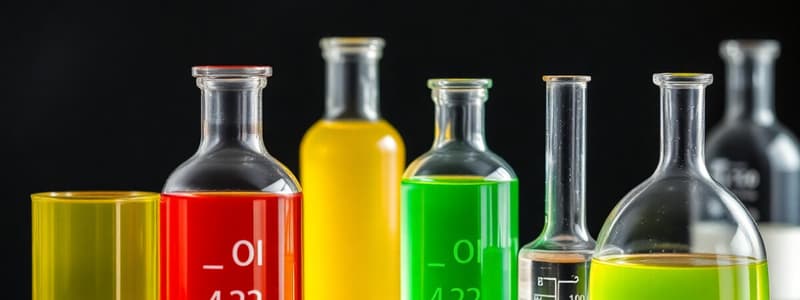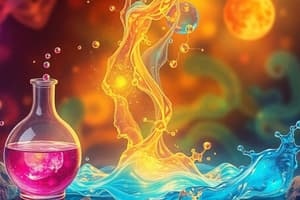Podcast
Questions and Answers
Which acid is considered the strongest due to the delocalization of negative charge?
Which acid is considered the strongest due to the delocalization of negative charge?
- HBr
- HI (correct)
- HF
- HCl
A Lewis base can form a new covalent bond by accepting a pair of electrons.
A Lewis base can form a new covalent bond by accepting a pair of electrons.
False (B)
What type of reaction occurs when HCl dissolves in water?
What type of reaction occurs when HCl dissolves in water?
Proton-transfer reaction
An organic cation where a carbon is bonded to three atoms and carries a positive charge is called a _______.
An organic cation where a carbon is bonded to three atoms and carries a positive charge is called a _______.
Match the acid with its dissolution medium:
Match the acid with its dissolution medium:
What does an Arrhenius acid produce when dissolved in water?
What does an Arrhenius acid produce when dissolved in water?
According to the Arrhenius definition, bases produce hydronium ions in water.
According to the Arrhenius definition, bases produce hydronium ions in water.
What is the term for a substance that acts as a proton donor according to the Brønsted-Lowry definition?
What is the term for a substance that acts as a proton donor according to the Brønsted-Lowry definition?
A substance that produces hydroxide ions (OH–) when dissolved in water is known as a __________.
A substance that produces hydroxide ions (OH–) when dissolved in water is known as a __________.
Match the following terms with their definitions:
Match the following terms with their definitions:
Which of the following is an example of an Arrhenius base?
Which of the following is an example of an Arrhenius base?
The conjugate acid of a base is the species that forms when the base donates a proton.
The conjugate acid of a base is the species that forms when the base donates a proton.
What is produced when hydrogen chloride (HCl) dissolves in water?
What is produced when hydrogen chloride (HCl) dissolves in water?
Which of the following compounds is a stronger acid?
Which of the following compounds is a stronger acid?
Resonance stabilization increases the acidity of the compound.
Resonance stabilization increases the acidity of the compound.
What is the relationship between the stability of an anion and the acidity of its corresponding acid?
What is the relationship between the stability of an anion and the acidity of its corresponding acid?
In terms of acid strength, the order of hydrogen halides is ___ > ___ > ___ > ___.
In terms of acid strength, the order of hydrogen halides is ___ > ___ > ___ > ___.
Match the following anions with their corresponding atomic radius order:
Match the following anions with their corresponding atomic radius order:
Which of the following factors contributes to the acidity of an acid?
Which of the following factors contributes to the acidity of an acid?
I– has a smaller atomic radius than F–.
I– has a smaller atomic radius than F–.
What phenomenon causes inductive polarization of electron density in acids?
What phenomenon causes inductive polarization of electron density in acids?
What defines a strong acid?
What defines a strong acid?
All Brønsted-Lowry acids must be positively charged.
All Brønsted-Lowry acids must be positively charged.
What are the three classifications of acids based on the number of protons they can donate?
What are the three classifications of acids based on the number of protons they can donate?
The conjugate base of acetic acid (CH3COOH) is ______.
The conjugate base of acetic acid (CH3COOH) is ______.
Match the acid with its corresponding conjugate base:
Match the acid with its corresponding conjugate base:
What defines a weak acid?
What defines a weak acid?
Which statement is true regarding the relationship between acids and their conjugate bases?
Which statement is true regarding the relationship between acids and their conjugate bases?
Carbonic acid (H2CO3) can donate two protons to become ______ and then ______.
Carbonic acid (H2CO3) can donate two protons to become ______ and then ______.
A strong acid produces a stronger conjugate base.
A strong acid produces a stronger conjugate base.
Ammonia (NH3) can act as both an acid and a base.
Ammonia (NH3) can act as both an acid and a base.
Name an example of a weak base.
Name an example of a weak base.
The ionization of a weak acid can be represented as HA ⇌ H+ + __________.
The ionization of a weak acid can be represented as HA ⇌ H+ + __________.
Match the terms with their definitions:
Match the terms with their definitions:
Which factor does NOT affect the relative acidity of an organic acid?
Which factor does NOT affect the relative acidity of an organic acid?
Equilibrium in acid-base reactions favors the formation of stronger acids and bases.
Equilibrium in acid-base reactions favors the formation of stronger acids and bases.
What happens to the stability of an anion as the electronegativity of the atom bearing the negative charge increases?
What happens to the stability of an anion as the electronegativity of the atom bearing the negative charge increases?
A Brønsted-Lowry acid must always be positively charged.
A Brønsted-Lowry acid must always be positively charged.
The stronger the acid, the stronger its conjugate base.
The stronger the acid, the stronger its conjugate base.
Carbonic acid can only donate one proton.
Carbonic acid can only donate one proton.
All strong acids completely ionize in water to form H3O+ ions.
All strong acids completely ionize in water to form H3O+ ions.
Ammonia (NH3) acts exclusively as a Brønsted-Lowry base.
Ammonia (NH3) acts exclusively as a Brønsted-Lowry base.
Acids produce hydroxide ions (OH–) when dissolved in water.
Acids produce hydroxide ions (OH–) when dissolved in water.
Brønsted-Lowry acids are defined as proton acceptors.
Brønsted-Lowry acids are defined as proton acceptors.
The species formed from an acid when it donates a proton is called a conjugate acid.
The species formed from an acid when it donates a proton is called a conjugate acid.
HCl dissolving in water leads to the formation of hydronium ions and chloride ions.
HCl dissolving in water leads to the formation of hydronium ions and chloride ions.
Bases that are not metal hydroxides produce hydroxide ions (OH–) by reacting with water molecules.
Bases that are not metal hydroxides produce hydroxide ions (OH–) by reacting with water molecules.
Acetic acid is a strong acid because it completely dissociates in water.
Acetic acid is a strong acid because it completely dissociates in water.
The position of equilibrium in an acid-base reaction lies on the side of the stronger acid.
The position of equilibrium in an acid-base reaction lies on the side of the stronger acid.
Electronegativity affects the stability of an anion, with more electronegative atoms leading to more stable anions.
Electronegativity affects the stability of an anion, with more electronegative atoms leading to more stable anions.
In acid-base reactions, the stronger acid reacts with the weaker base to produce stronger conjugate pairs.
In acid-base reactions, the stronger acid reacts with the weaker base to produce stronger conjugate pairs.
Resonance stabilization is a factor that can enhance the acidity of an organic acid.
Resonance stabilization is a factor that can enhance the acidity of an organic acid.
Flashcards
Arrhenius acid
Arrhenius acid
A substance that dissolves in water to produce hydronium ions (H3O+).
Arrhenius base
Arrhenius base
A substance that dissolves in water to produce hydroxide ions (OH–).
Hydronium ion
Hydronium ion
H3O+, formed when an acid dissolves in water.
Brønsted-Lowry acid
Brønsted-Lowry acid
Signup and view all the flashcards
Brønsted-Lowry base
Brønsted-Lowry base
Signup and view all the flashcards
Conjugate base
Conjugate base
Signup and view all the flashcards
Conjugate acid
Conjugate acid
Signup and view all the flashcards
Acid-base reaction
Acid-base reaction
Signup and view all the flashcards
Conjugate Acid-Base Pair
Conjugate Acid-Base Pair
Signup and view all the flashcards
Strong Acid
Strong Acid
Signup and view all the flashcards
Strong Base
Strong Base
Signup and view all the flashcards
Monoprotic Acid
Monoprotic Acid
Signup and view all the flashcards
Diprotic Acid
Diprotic Acid
Signup and view all the flashcards
Acid Strength & Conjugate Base Strength
Acid Strength & Conjugate Base Strength
Signup and view all the flashcards
Weak Acid
Weak Acid
Signup and view all the flashcards
Weak Base
Weak Base
Signup and view all the flashcards
Acid-Base Equilibrium
Acid-Base Equilibrium
Signup and view all the flashcards
Weaker Acid
Weaker Acid
Signup and view all the flashcards
Anion Stability
Anion Stability
Signup and view all the flashcards
Electronegativity Influence
Electronegativity Influence
Signup and view all the flashcards
Resonance Stabilization
Resonance Stabilization
Signup and view all the flashcards
Lewis acid
Lewis acid
Signup and view all the flashcards
Lewis base
Lewis base
Signup and view all the flashcards
What is the strongest Lewis base in water?
What is the strongest Lewis base in water?
Signup and view all the flashcards
What is a carbocation?
What is a carbocation?
Signup and view all the flashcards
Inductive effect
Inductive effect
Signup and view all the flashcards
What is the trend of acidity with anions?
What is the trend of acidity with anions?
Signup and view all the flashcards
Resonance
Resonance
Signup and view all the flashcards
Carboxylic Acid vs. Alcohol
Carboxylic Acid vs. Alcohol
Signup and view all the flashcards
Inductive Effect on Acid Strength
Inductive Effect on Acid Strength
Signup and view all the flashcards
What is the relationship of acid strength and anion size?
What is the relationship of acid strength and anion size?
Signup and view all the flashcards
Atomic Size Trend
Atomic Size Trend
Signup and view all the flashcards
Anion Size vs. Atomic Size
Anion Size vs. Atomic Size
Signup and view all the flashcards
What does an Arrhenius acid produce in water?
What does an Arrhenius acid produce in water?
Signup and view all the flashcards
What does an Arrhenius base produce in water?
What does an Arrhenius base produce in water?
Signup and view all the flashcards
How does HCl act as an acid?
How does HCl act as an acid?
Signup and view all the flashcards
What is a conjugate acid-base pair?
What is a conjugate acid-base pair?
Signup and view all the flashcards
Identify the conjugate acid and base in the reaction: HCl + H2O -> H3O+ + Cl-
Identify the conjugate acid and base in the reaction: HCl + H2O -> H3O+ + Cl-
Signup and view all the flashcards
pKa Value
pKa Value
Signup and view all the flashcards
Equilibrium in Acid-Base Reactions
Equilibrium in Acid-Base Reactions
Signup and view all the flashcards
Factors Affecting Acidity
Factors Affecting Acidity
Signup and view all the flashcards
Study Notes
Arrhenius Acids and Bases
- In 1884, Arrhenius defined acids as substances that dissolve in water to produce hydronium ions (H3O+).
- Arrhenius defined bases as substances that dissolve in water to produce hydroxide ions (OH-).
- This definition slightly modifies the original Arrhenius definition, where an acid produces H+ in aqueous solution.
- Today, H+ immediately reacts with a water molecule to form hydronium.
Arrhenius Acids and Bases (Example)
- HCl, when dissolved in water, reacts with water to produce a hydronium ion and a chloride ion.
- The reaction is shown using curved arrows to depict electron pair movement.
Arrhenius Acids and Bases (Bases)
- Many bases are metal hydroxides like KOH, NaOH, Mg(OH)2, and Ca(OH)2.
- These are ionic solids that dissociate into their constituent ions when dissolved in water.
Brønsted-Lowry Acids and Bases
- An acid is a proton donor.
- A base is a proton acceptor.
- Conjugate base: the species formed when an acid donates a proton to a base.
- Conjugate acid: the species formed when a base accepts a proton from an acid.
- Acid-base reactions involve proton transfer.
- Conjugate acid-base pairs are interconvertible via proton transfer.
Conjugate Acids & Bases (Example)
- HCl (acid) reacts with H₂O (base) to form Cl- (conjugate base of HCl) and H3O+ (conjugate acid of H₂O).
Brønsted-Lowry Acids and Bases (No Water)
- The Brønsted-Lowry definitions don't require water as a reactant.
- For example, acetic acid (CH3COOH) reacting with ammonia (NH3) forms acetate ion (CH3COO-) and ammonium ion (NH4+).
Brønsted-Lowry Acids & Bases (Further Explanation)
- The reaction using curved arrows, showing electron flow during proton transfer, demonstrates how the reaction happens.
Table 2.1 (Some Acids and Their Conjugate Bases)
- Acids can be positively, negatively, or neutrally charged (e.g., H3O+, H2CO3, H2PO4-).
- Bases can be negatively or neutrally charged (e.g., OH-, Cl-, NH3).
- Acids are classified as monoprotic, diprotic, or triprotic based on the number of protons they release (e.g., HCl, H2CO3, H3PO4).
Brønsted-Lowry Acids & Bases (Carbonic Acid)
- Carbonic acid (H2CO3) can release one proton to form bicarbonate (HCO3-) and then a second proton to form carbonate (CO32-).
Brønsted-Lowry Acids & Bases (Relationship)
- The strength of an acid is inversely related to the strength of its conjugate base.
- The stronger the acid, the weaker its conjugate base (e.g., HI is stronger than CH3COOH).
Acid and Base Strength (Definitions)
- Strong acid: reacts completely or almost completely with water to produce H3O+ ions.
- Strong base: reacts completely or almost completely with water to produce OH- ions.
- Examples include HCl, HBr, HI, HNO3, H2SO4, and HClO4 (acids). LIOH, NaOH, KOH, Ba(OH)2 (bases)
Acid and Base Strength (Weak)
- Weak acid: partially dissociates in water, producing H3O+ ions (e.g., CH3COOH)
- Weak base: partially dissociates in water, producing OH- ions (e.g., NH3).
Acid-Base Reactions (Ionization of Weak Acids)
- Acetic acid is incompletely ionized in aqueous solutions.
- The equation represents a weak acid ionizing (HA + H2O ⇌ A- + H3O+).
- The equilibrium constant (Ka) relates the concentrations of reactants and products.
pKa Values
- pKa values are used to compare the relative strength of acids; the smaller the pKa the stronger the acid.
- pKa values for different types of organic and inorganic acids are listed and categorized.
Acid-Base Equilibria
- The position of equilibrium in acid-base reactions is determined by comparing the strengths of the acids involved.
- Stronger acid reacts with stronger base to produce weaker acid and weaker base.
- Equilibrium lies on the side of weaker acid and weaker base.
Structure and Acidity (Key Factors)
- Relative stability of the anion (A-) formed when the acid (HA) loses a proton.
- Four factors are:
- Electronegativity of the atom bonded to H in HA.
- Resonance stabilization of A⁻.
- Inductive effect.
- Size and delocalization of charge in A⁻.
Structure and Acidity (Electronegativity)
- Electronegativity of the atom bearing the negative charge affects the strength of acid; higher electronegativity leads to more stable anion.
- Within a period, increasing electronegativity increases acidity.
Structure and Acidity (Resonance)
- Compare the acidity of carboxylic acids and alcohols.
- carboxylic acids are stronger acids than alcohols due to resonance stabilization of the carboxylate anion.
Structure and Acidity (Inductive Effect)
- Inductive effect describes polarization of electron density through covalent bonds due to a nearby atom with higher electronegativity.
- Higher electronegativity of nearby atoms generally leads to stronger acids.
Structure and Acidity (Size and Delocalization)
- Larger volume over which negative charge is delocalized, the more stable the anion.
- For halogens, the larger atomic radii of iodide allows for more delocalization, making HI stronger acid.
Lewis Acids and Bases (Definition)
- Lewis acid: accepts a pair of electrons to form a new covalent bond.
- Lewis base: donates a pair of electrons to form a new covalent bond.
Lewis Acids and Bases (HCl in Water Example)
- HCl dissolves in water, donating a proton (H+) to a water molecule (Lewis base), forming a hydronium ion (H3O+).
Lewis Acids and Bases (HCl in Methanol Example)
- HCl dissolves in methanol, donating H to CH3OH, forming an oxonium ion.
Lewis Acids and Bases (Table 2.3)
- The table organizes some organic Lewis bases and their relative strengths in proton-transfer reactions.
Lewis Acids and Bases (Carbocations)
- Carbocation: a carbon cation carrying a positive formal charge, bonded to only three atoms.
- Carbocation is a Lewis acid, accepting electron pairs.
Studying That Suits You
Use AI to generate personalized quizzes and flashcards to suit your learning preferences.




